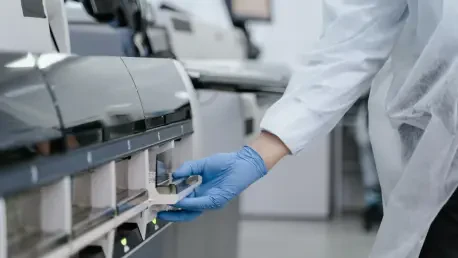The world of clinical laboratories is undergoing a seismic shift as healthcare systems navigate the transformative waves of the Fourth Industrial Revolution (4IR) and prepare for the anticipated Fifth Industrial Revolution (5IR). Automation and advanced data management are driving this change, fundamentally altering how diagnostics are performed and elevating the role of labs from mere support functions to vital components of a responsive, data-centric healthcare ecosystem. This evolution is not just about adopting new tools; it represents a strategic imperative to address mounting challenges like workforce shortages, escalating test volumes, and the growing complexity of medical diagnostics. By integrating cutting-edge technologies such as artificial intelligence (AI) and machine learning, labs are becoming hubs of innovation, poised to deliver faster, more accurate results while shaping the future of personalized medicine. This transformation signals a broader industrial shift, where technology and human expertise must align to meet the demands of modern healthcare.
Harnessing Technology for Diagnostic Innovation
As clinical laboratories adapt to the demands of the 4IR, technology stands as the cornerstone of their transformation, moving far beyond the basic automation of repetitive tasks. Today’s systems are intelligent and integrated, leveraging AI and machine learning to manage intricate workflows with unprecedented precision. These advanced platforms can autonomously prioritize urgent samples, detect subtle anomalies in test results, and even suggest diagnostic pathways, thereby enhancing both efficiency and accuracy. This shift reflects the 4IR’s emphasis on fusing digital, physical, and biological systems, creating a seamless diagnostic environment that responds dynamically to clinical needs. For labs, adopting such technologies is not merely an upgrade but a necessity to remain competitive and relevant as healthcare moves toward more predictive and personalized approaches.
The impact of these technological advancements extends into the very fabric of lab operations, redefining what efficiency means in a clinical setting. Unlike earlier automation focused solely on high-volume processing, modern systems are designed for adaptability, capable of self-monitoring and adjusting to varying workloads. This capability ensures that labs can handle sudden spikes in demand without compromising quality, a critical factor given the increasing prevalence of chronic conditions and aging populations. Moreover, the integration of Internet of Things (IoT) devices allows for real-time tracking of equipment and samples, minimizing errors and delays. As labs prepare for the 5IR, where human-AI collaboration will take center stage, mastering these tools now lays the groundwork for delivering diagnostics that are not only faster but also deeply tailored to individual patient needs.
Addressing Structural Challenges with Automation
The push for automation in clinical labs is driven by a confluence of structural challenges that threaten to overwhelm traditional operational models. A persistent global shortage of skilled technologists, combined with a surge in test volumes due to demographic shifts like aging populations, has created a perfect storm of demand that manual processes cannot sustain. Automation offers a lifeline by filling these workforce gaps, enabling labs to scale operations without a proportional increase in staff. Additionally, the rise of precision medicine, which demands highly specialized and complex testing, further underscores the need for automated systems that can maintain consistency and accuracy under pressure. These technologies also ensure compliance with stringent regulatory standards by standardizing processes and providing traceable data, a critical requirement in today’s healthcare landscape.
Beyond simply managing workload, automation serves as a strategic solution to enhance the quality and reliability of diagnostic outcomes. By reducing the reliance on manual intervention, automated systems minimize the risk of human error, which can be particularly costly in high-stakes environments where a single misstep can affect patient care. This reliability is vital as labs face increasing scrutiny to deliver results that meet both clinical and legal expectations. Furthermore, automation enables labs to allocate human resources more effectively, redirecting skilled professionals from routine tasks to areas requiring critical thinking and oversight. As healthcare systems grapple with rising costs and resource constraints, the ability of automation to streamline operations while upholding high standards positions it as an indispensable tool for labs aiming to thrive amid these industrial shifts.
Data Integration as a Catalyst for Change
Data integration has emerged as a pivotal force in the evolution of clinical laboratories, transforming them from isolated units into interconnected nodes within a broader healthcare network. The sheer volume and diversity of data generated by modern diagnostics necessitate advanced laboratory information systems (LIS) that can process and analyze information in real time. These platforms enable labs to identify patterns and trends that inform predictive healthcare, allowing for earlier interventions and more effective treatment plans. By connecting disparate data streams, labs contribute to a holistic view of patient health, supporting the shift toward precision diagnostics that tailor care to individual needs. This data-driven approach marks a significant departure from traditional roles, positioning labs as key players in shaping clinical outcomes.
The broader implications of data integration extend into public health and strategic planning, amplifying the influence of labs on a global scale. Integrated data systems facilitate epidemiological modeling, helping to track disease outbreaks and inform response strategies with actionable insights. This connectivity also supports clinical informatics, enabling labs to collaborate with other healthcare entities to refine diagnostic protocols and improve care delivery. As data becomes the lifeblood of modern medicine, labs equipped with robust management systems can drive innovations that range from personalized therapies to global disease surveillance. This transformation underscores the strategic value of data, turning labs into essential assets that not only support individual patient care but also contribute to the overarching goals of healthcare systems navigating industrial revolutions.
Redefining the Workforce for a Digital Era
Automation in clinical labs is not about replacing human expertise but rather about elevating it to meet the demands of a rapidly changing field. By handling repetitive and time-consuming tasks, automated systems free up lab professionals to focus on higher-value activities such as data interpretation, quality assurance, and interdisciplinary collaboration with other healthcare teams. This shift necessitates a new skill set, including proficiency in data analysis and familiarity with AI-driven tools, which are becoming integral to diagnostic processes. Continuous training and professional development are essential to ensure that staff remain agile and capable of leveraging these technologies effectively, preparing them for an environment where technical and analytical competencies are equally valued.
Looking ahead, the workforce must adapt to the vision of the “smart lab,” where autonomy and connectivity redefine operational norms. While automation empowers professionals, it also introduces challenges such as the need to navigate interoperability issues and address cybersecurity risks associated with digital systems. Despite these hurdles, the potential for labs to become central to collaborative care models is immense, provided the workforce is equipped to handle emerging responsibilities. Investment in education and upskilling will be crucial to bridge any gaps, ensuring that lab personnel can oversee intelligent systems while contributing to broader health initiatives. This evolution of roles highlights how automation serves as a catalyst for professional growth, aligning human talent with technological progress in the journey through industrial shifts.
Building Toward a Future of Smart Diagnostics
Reflecting on the strides made, automation and data management have already redefined clinical laboratories, positioning them as indispensable pillars of a responsive healthcare framework during the 4IR. These advancements have tackled critical issues like workforce shortages and diagnostic complexity, delivering precision and scalability that manual methods could never achieve. Data integration has paved the way for predictive care, while automation has empowered professionals to take on strategic roles, shaping outcomes with newfound insight. Barriers such as high implementation costs and technical challenges have been acknowledged and addressed through careful planning, ensuring labs remain on a path of progress.
Moving forward, the focus must shift to actionable strategies that solidify these gains and prepare for the 5IR’s emphasis on human-AI synergy. Healthcare organizations should prioritize investments in interoperable systems to enhance connectivity across networks, while robust cybersecurity measures must safeguard sensitive data. Equally important is the commitment to workforce development, equipping staff with the tools and knowledge to thrive in smart labs. By viewing automation as a long-term strategic asset rather than a short-term fix, labs can continue to innovate, driving collaborative care and influencing global health policies with data-driven precision.









